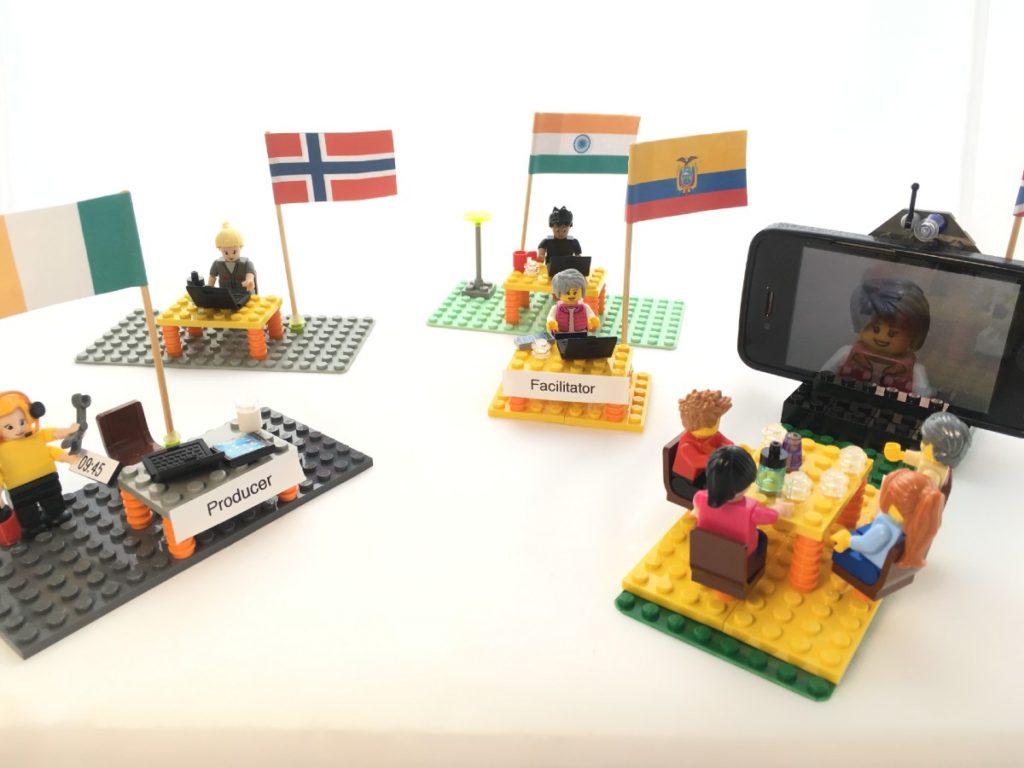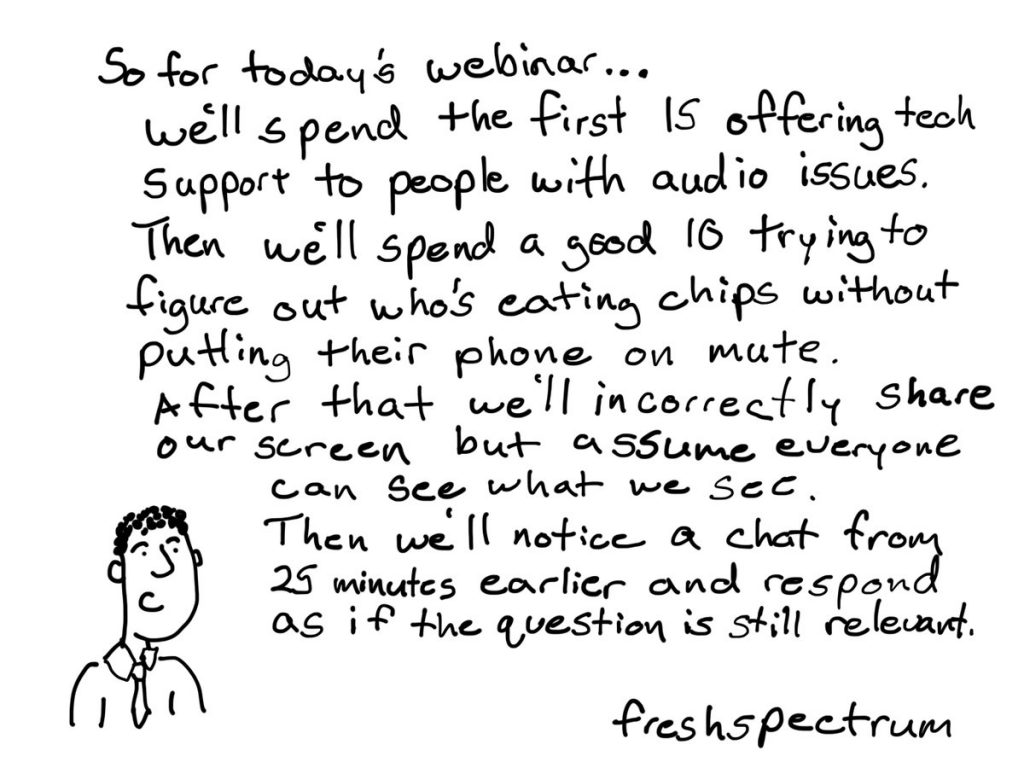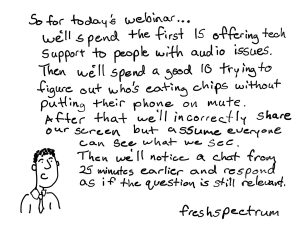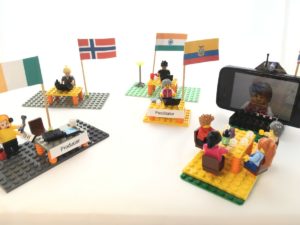Tag Archives: virtual facilitation
Feb
Design principles for humane hybrid events
Hybrid gatherings have been happening for years, from the team meeting where we arrive and hear that ‘Mary is going to dial in’, to a company wide ‘all hands’ meeting where national teams convene in conference rooms around the globe. Many organisations are starting to plan for hybrid gatherings in anticipation of at least partial lifting of lockdown.
Many facilitators, myself included, when approached to design a hybrid event, start with ‘are you *really* sure you want one?’! A hybrid event is effectively three events comprising: the people co-located in a physical space (the ‘Roomies’), the people who are joining by phone or virtual meeting platform (the Zoomies), and the meeting where you are trying to link all of these participants together: the Full Catastrophe, as Zorba the Greek might call it.
I have spent lots of time trying to map the variations of hybrid meetings using pods and nodes and network diagrams, but I realised that was a little like planning to bake a cake and only thinking about the receptacle – round tin or square tin or muffin tins or even paper bun cases – rather than focusing on whether I wanted a lemon drizzle cake, or banana bread or [insert your favourite lockdown treat here!]. I want my cake to be tasty and perhaps even a bit healthy, and I’ll probably manage to make it roughly the right flavour and texture, regardless of the kind of tin I use. Similarly, I want to help people achieve their aims for an event, regardless of the technical configuration of wires and pods and nodes. ‘Hybridity’ is the means rather than the end. We don’t set out to have a ‘hybrid’ meeting, we set out to bring people together to achieve something.
So, let’s leave aside the different containers and configurations and logistics to focus on what’s really important. There are two crucial elements particular to hybrid gatherings which, if we get them right, will help people do the work they have convened to do, and help them to actually thrive doing it. I’ve called these two elements ‘coherence’ and ‘connection’.
‘Coherence’ is the extent to which everyone can contribute to and receive all parts of the event. This particularly refers to having access to other participants’ (verbal or written) contributions (as distinct from just the input of keynote speakers or panels). Literally and metaphorically, it means everyone being ‘on the same page’, even as that page fills up with questions, ideas, insights and other contributions from participants. It enables people to feel heard, whether that is in writing, or verbally.
Coherence is an aspect of events that we can take for granted when we are all co-located in either virtual or physical space but it requires really careful design when people are working in different spaces. Different media and tools become vital, for example flip charts, ‘stickies’, virtual whiteboards, or shared electronic documents.
As a simple example, in a workshop with GlobaltFokus, where the trainer and producer were remote and the participants were co-located, participants photographed the flip charts they generated in their small group work and uploaded them to the (virtual) meeting platform we were using. This enabled the trainer and all the other participants to see each group’s material projected on a screen, and discuss them during plenary.
Connection is the extent to which everyone in the room has an opportunity for some meaningful human interaction. That can be obtained from interacting with others in general, but it becomes a more compelling and richer experience when it occurs with a more intimate pair or small group (up to 5). This kind of connection often starts to happen naturally at face to face events, over coffee, while we’re waiting to start, and during breaks. We’re all getting much better at building it into virtual events, using a range of tasks and tools to enable people to have conversations in smaller groups, with breakouts being the best example. But once we move into hybrid events, it is all too easy, particularly in relation to social time, to let the ‘Roomies’ do their own social thing, and leave the remote ‘Zoomies’ to step away by themselves. This has the effect of creating two diverging meetings – the virtual one and the face to face one, and it particularly disadvantages the remote participants. Of course, remote participants may be able to get light relief, stimulation and empathy from others in their immediate location (though not even that at the moment, where so many of us are working in solitary home offices), but putting real thought and effort into helping everyone build some familiarity, empathy and understanding with at least some other participants will help to increase engagement at the event and commitment to the outcomes, and will create an experience of inclusion, of really mattering. All of these make it easier to keep people present and involved, to identify and address dissent and resolve conflict, to sow the seeds for consensus, and crucially, to support participants towards collective action.
In an event we facilitated recently, with 11 co-located participants and two remote participants, we used a separate, lighthearted messaging channel where photographs and snippets were shared among all event participants, whether co-located or remote. This simple addition helped to give the Zoomies a sense of being remembered and included, and helped to remind the Roomies that there were important voices outside the main room.
There’s plenty more to talk about in relation to how to do all of this, and I’ll save that for my next post, but let’s cut to the chase cake: participatory, engaging and productive hybrid events can be delivered by using the concepts of coherence and connection to design a unified – and unifying – event for all participants.
Tagged | collaboration, facilitation, hybrid, leadership, meetings, participation, remote teams, teamwork, virtual facilitation, virtual meetings, virtual workshops
Jul
Virtual facilitation training
Now taking bookings for the next round of our Facilitating Great Virtual Events course. Starting 15th September, and already filling up! https://www.ica-uk.org.uk/course/facilitating-virtual-events-i-online-i-sept/

Tagged | facilitation, virtual facilitation, virtual workshop; facilitation;
May
Virtual facilitation – podcast
IAF England and Wales have started up a podcast on matters facilitative. I have the honour of appearing briefly on the third episode, talking about my journey in virtual facilitation https://www.listennotes.com/podcasts/facilitation-stories/fs17-how-facilitators-are-McbSB9T_5zA/
Tagged | facilitation, virtual facilitation
Jan
Training in virtual facilitation

Avoid this, by learning how to design and facilitate engaging, inclusive and productive online workshops. The long standing online training in virtual facilitation, on which Orla has been collaborating for the past 5 years, starts again on 16th January, and there is *one* seat left. The course runs remotely, on 8 consecutive Thursdays, at 15:00 UTC/GMT. Bespoke/in house training on your preferred conferencing platform is also available: contact orla@orlacronin.com With thanks to Chris Lysy for the cartoon.
Tagged | training, virtual facilitation, virtual workshop; facilitation;
Jun
Online training
I am embroiled in preparing for 2 online courses at the moment. One is the Intrac Online M&E course – we have 17 participants spanning 4 continents. We’re using Moodle as the asynchronous course platform, for discussions, homework and resources, and Blackboard Collaborate as the synchronous workshop/seminar platform.
I’m also starting to train today on an in-house Virtual Facilitation Online course with the Center for Disease control in the US, alongside with my ICA:USA colleagues Ester Mae Cox, Nileen Verbeten, Brenda Schmidt and Sheila Cooke. For this, we’re using Wiggio for the asynchronous component, and Adobe Connect for the workshops.
This is giving me a great opportunity to compare and contrast different platforms. Part of course design, in addition to creating content, is designing for learning and fostering peer interaction: this is often sacrificed in online training, but in fact, it becomes even more important to design, as it doesn’t necessarily happen naturally when people aren’t milling around drinking coffee together and chatting when they sit beside each other.
Within our training, we’re pushing ourselves to continuously model best practice in online facilitation…. to avoid webinar-induced comas!

Tagged | facilitation, M&E, training, virtual facilitation
May
Effective virtual meetings and workshops
Today was a real milestone for OCR. Thanks to wonderful training provided by the ToP Bootcamp provided by Sheila Cooke and Esther Mae Cox, we have just run our first large scale virtual workshop across 3 continents.
We now offer virtual workshop facilitation as part of OCR’s offering to clients around the world. This approach brings many benefits, including, of course, the opportunity to increase participation of staff or stakeholders, time savings as a result of reducing national and international travel time, and reduction in your carbon footprint. One of the reasons I personally am so excited is that it feels like real progress in aligning OCR’s activities with my own core values. Though it’s always wonderful to work with clients in their home base, I’m increasingly uncomfortable with the personal, organisational and environmental costs of long haul travel.
Today’s meeting (involving senior staff at a large NGO) took place with 12 individuals sitting in Germany, UK, South Africa, Brazil and the US. It ran for 3 hours and we made substantial progress on a strategic task we had started during a 2 day face to face meeting in Berlin. The team found the experience interesting and productive. We even had an opportunity for some banter!
We’ll post some FAQ soon in relation to virtual workshops. In the meantime, do get in touch if you’d like to discuss possibilities for your organisation.
Tagged | virtual facilitation




